Seared Ahi Tuna
This Seared Ahi Tuna with Orange Avocado Salsa is easy to make, and has tons of flavor thanks to a simple 2-ingredient marinade. It’s a delicious dinner fit for company or a special occasion, and very healthy. It only takes 25 minutes, including marinating time.
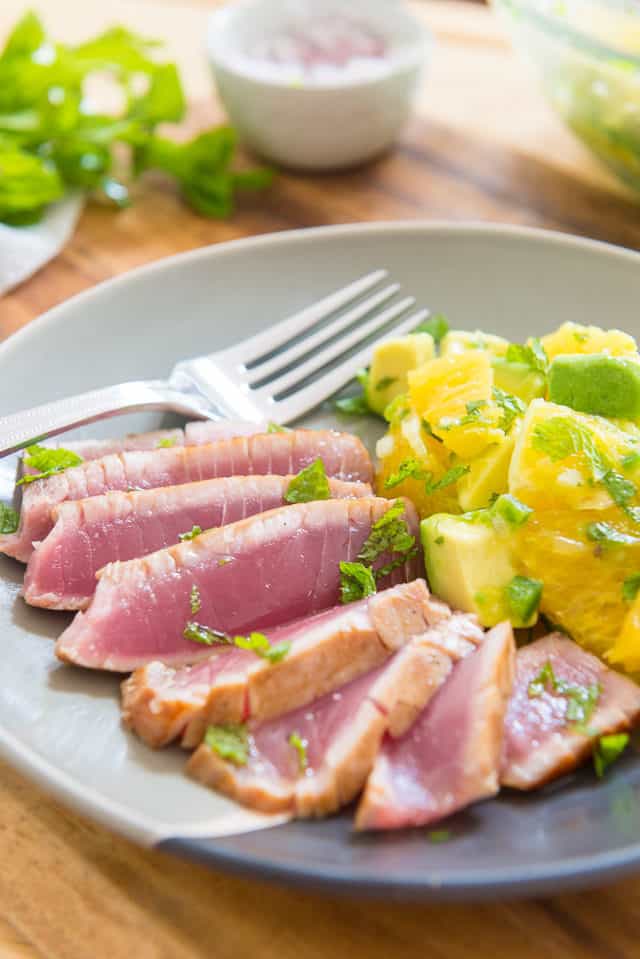
Even though ahi tuna is often thought of as fancy restaurant food, it’s shockingly easy to make at home.
This is true of most seafood in general, and most people find they can make Pan Seared Salmon or Seared Scallops just as well as the restaurants but at a fraction of the cost.
Since most of the enjoyment of this fish is all about cooking it properly and not overpowering the flavor, you don’t want the preparation to be overly complicated anyway.
So for this recipe, we make a simple 2-ingredient marinade, and in the meantime make a simple orange avocado salsa with flavors like mint and jalapeño.
It’s really refreshing and light, and much cheaper than what you’d pay at a restaurant!
Tips for Best Results
Pat the fish very dry – After you marinade the tuna steaks, you’ll want to pat the exterior dry with paper towels to absorb the excess liquid. This will ensure you get a good sear on the outside.
Get the pan screamin’ hot for searing – You barely want to cook the raw fish overall, so the time in the skillet needs to be minimal. To get the best sear on the outside in the shortest amount of time, make sure you preheat the skillet well.
Step by Step Overview:
Making this seared ahi tuna dish is simple, with the following game plan: Marinate the tuna, make the salsa while the fish marinates, then quickly sear the fish and serve together.
Tips for Buying the Fish
When you go to your local grocery store to purchase the fish, know that Ahi can actually refer to one of two species: bigeye tuna and yellowfin tuna. Either type of tuna will work here. Bluefin tuna is also great but very expensive.
Because the interior of the tuna steak will be served raw, you’ll want to find the best tuna steaks from a reputable store. Sashimi grade, or sushi-grade fish, can mean it’s better quality, but know that there are no actual regulations around this labeling. You’re really trusting the seller. Here’s what you should look for otherwise:
Cut to order or recently cut – Best case scenario is the fishmonger cutting your tuna steaks fresh from the whole loin, but this will be rare. At the very least, ask when the fish was cut, and make sure the steaks don’t look like they’re starting to brown.
Shiny and moist exterior – Look how the fish glistens with moisture in the photo below. That is how the tuna should look in the case. It should look very moist and shiny, indicating it was freshly cut. If it’s looking dry and starting to brown, pass on the fish.
Tight flesh – As the tuna starts to get old, the flesh will start to separate, particularly that muscle piece on the side. Make sure the flesh looks tightly connected.
Smell – This is an easy giveaway, but because it’s a little more awkward to ask for this versus using the visual cues, I tend look at the other aspects first. Fresh fish should smell pleasantly of the ocean, and not overly fishy.
Marinate the fish
To marinate the tuna steaks, we’ll be using fresh orange juice and soy sauce. It’s very simple, but gives a great balance of umami, savory, sweet, and bright.
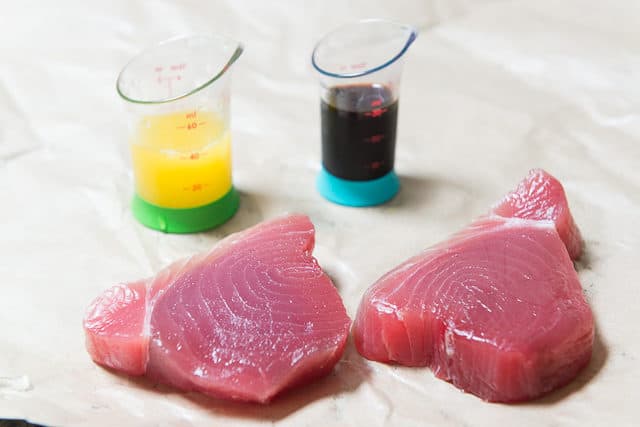
Combine the steaks and ahi tuna marinade ingredients in a bag, then place back into the fridge:
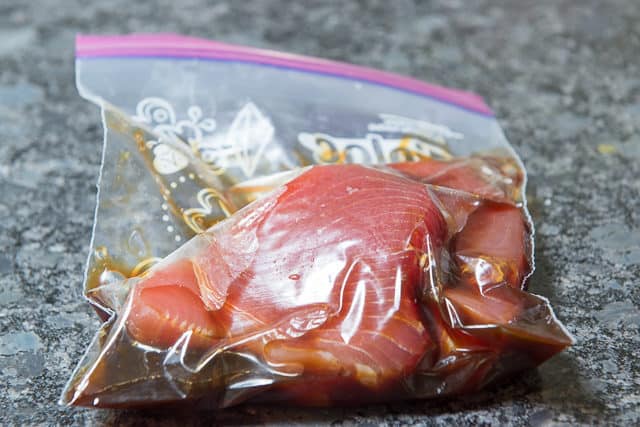
Can you use frozen fish?
Fresh ahi tuna is best, but it’s fine to use a previously frozen ahi tuna steak, with a few caveats.
First, make sure it’s intended to eat sashimi-style, and has been deep frozen to kill any potential bacteria or parasites.
Then, either thaw it overnight in the fridge or do a quick thaw in the package, running it under cold water for 20 minutes or so.
Make the salsa
While the tuna steaks marinate, combine fresh orange segments, minced jalapeño, fresh mint leaves, shallot, salt, and olive oil in a small bowl:
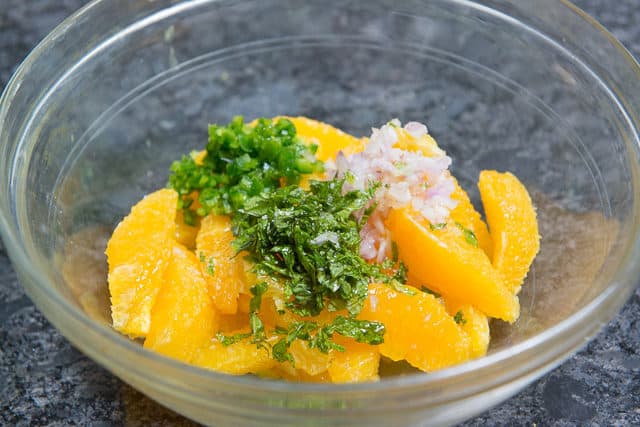
Here’s a quick guide for How to Segment an Orange with just a paring knife and a cutting board, if you’re not sure how to do it.
Mix that all together to combine, then add diced avocado and a pinch more of kosher salt, at the end:
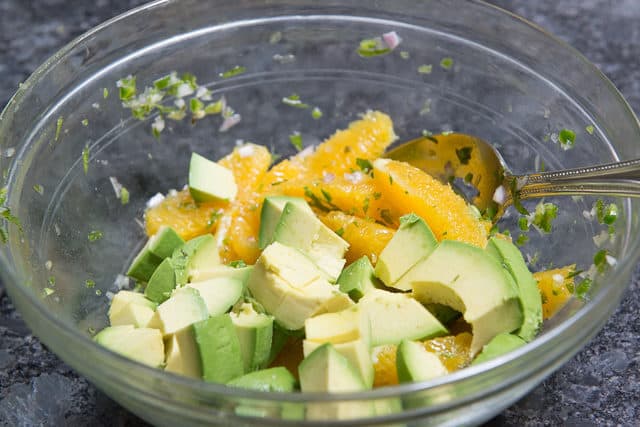
That way you don’t accidentally overmash the avocado while stirring.
Toss to coat the avocado in all the flavors, and the salsa is ready:
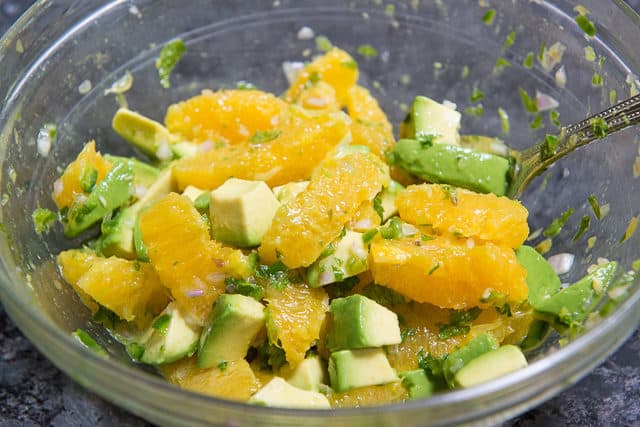
Now it’s time to put it all together!
Sear the fish
Preheat a cast iron skillet over high heat, and add a tablespoon of any oil with a high smoke point, such as avocado oil.
Pat the ahi steaks dry with a paper towel, then add to the pan:
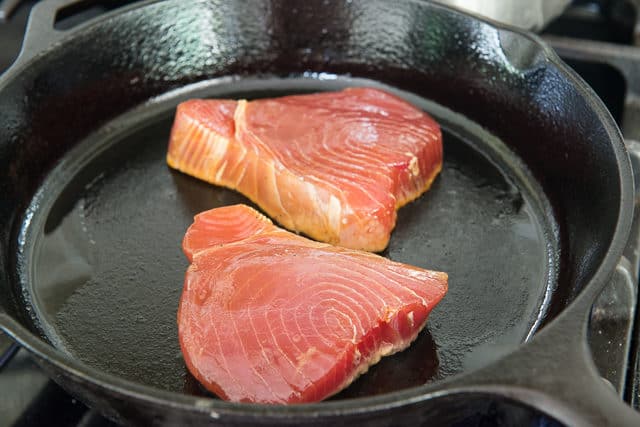
I like that the cast-iron skillet retains heat really well, and that it’s also a nonstick skillet, but you may also use any other heavy bottomed pan. Preheat well to get that perfect sear.
Try to keep the interior as rare as possible, only searing the outsides until golden, about 1-2 minutes on each side:
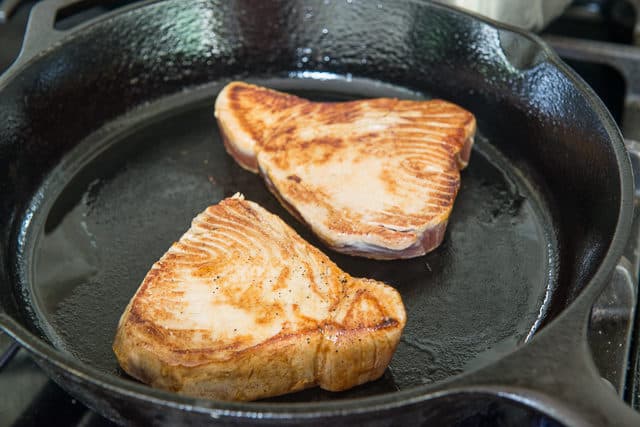
(If the pan starts smoking excessively, turn the heat setting down to medium-high heat).
Then I make sure to rub any pink spots on the sides against the hot skillet as well, to kill any bacteria on the outside.
How to Serve
Carefully slice each ahi tuna steak very thinly with a sharp knife, and fan the slices out on the plate. Then serve with the orange avocado salsa on the side, and extra chopped mint over the sliced tuna.
This dish can certainly serve as the whole meal, but if you’d like to add some extra dishes to the side, I recommend pairing other light options like a fresh Coleslaw, Roasted Beets, or Roasted Fennel.
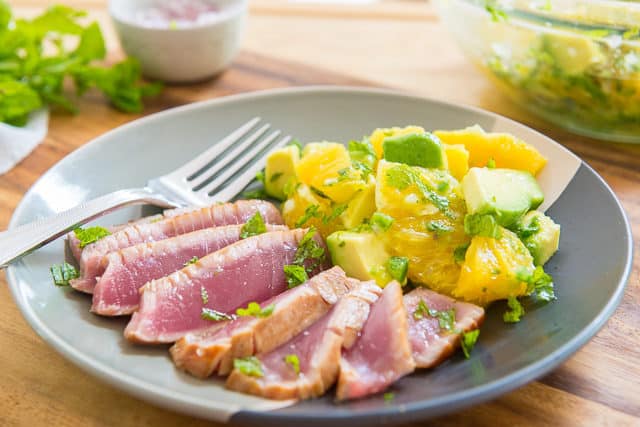
I recommend eating it all together, with bites of orange and avocado with each bite of tuna.
You can also dice this to make something reminiscent of a poke bowl, with white rice as a base.
For more of my favorite fish and seafood recipes, try Baked Salmon, this light Shrimp Salad, or my favorite Lobster Roll Recipe. Or try my favorite appetizers, Crab Cakes and Coconut Shrimp.
FAQ and Tips:
Generally no food is completely guaranteed to be safe to eat, because you’re relying on the grocery store to have properly handled everything and humans make mistakes. You just don’t know. If you can, try to find sashimi grade tuna, but know that it’s not actually regulated.
Yes, for up to 1 day in the fridge in an airtight container.
This is not recommended.
I like Rice Pilaf, Shaved Fennel, Orange & Beet Salad, and Broccoli Salad.
It’s a great flavor to add here. If you want to use sesame oil, do not put it in the marinade, as it will be prone to burning during the sear. You can incorporate it into some sort of dipping sauce (I recommend using the dipping sauce from my Asian Dumplings. Or you can add some black or white sesame seeds on top for garnish.
Recipe Variations
Citrus – The orange is acidic, but relatively sweet. To make it brighter, feel free to dress with 1 tablespoon of lime juice.
Spice – Feel free to add freshly ground black pepper or cayenne pepper to the orange salsa to add some heat.
Onion – In place of the shallot, you may use finely chopped green onions or red onion instead.
Did you enjoy the recipe? Please leave a 5-star rating in the recipe card below and/or a review in the comments section further down the page. Or, follow me on Facebook, Instagram or Pinterest!

Seared Ahi Tuna with Orange Mint Avocado Salsa
Ingredients
For the Tuna:
- 2 tbsp soy sauce
- 3 tbsp orange juice
- 2 6-ounce ahi tuna steaks
- 1 tbsp high heat cooking oil such as avocado oil
For the Orange Avocado Salsa:
- 3 navel oranges
- 1 jalapeno finely minced (2 tbsp)
- 2 tbsp chopped fresh mint
- 2 tbsp finely chopped shallot
- 1 tbsp extra virgin olive oil
- 1/4 tsp salt divided
- 1 avocado diced
Instructions
- Place the soy sauce, orange juice, and tuna steaks into a bag, and let marinate in the fridge for 20 minutes.
- In the meantime, prepare the salsa. Cut the oranges into segments (see How to Segment an Orange if you don’t know how), and place into a bowl.
- Add the jalapeno, mint, shallot, oil, and 1/8 tsp salt, and stir to combine.
- Add the avocado and remaining 1/8 tsp salt, and toss gently, just enough to coat the avocado with the other ingredients.
- Preheat a skillet, preferably cast iron, over high heat, until the pan starts to smoke. In the meantime, pat the fish dry with paper towels.
- Add the high heat cooking oil, then sear the tuna on each side for about 60-90 seconds, until browned. The pan should be hot enough that it sizzles loudly when you add the tuna.
- Once the bottom and top are seared and golden, rub any leftover exposed pink surfaces on the sides against the pan, to cook all exterior parts of the fish.
- Thinly slice the fish, then arrange on a plate with the orange avocado salsa on the side. Enjoy!
Notes
Nutrition
Nutrition is estimated using a food database and is only intended to be used as a guideline for informational purposes.
Post updated October 2018. Originally published December 2010.

5 Comments on “Seared Ahi Tuna”
Love the ahi tuna receipe
your blog is really beautiful! What kind of camera / lens / lighting are you using?
k gibson
http://allseasonscuisine.com
Hi! Thank you =) Haha, not using any fancy camera. It’s actually a test production camera that my husband’s dad gave to us (just a point and shoot). I will be getting a dSLR soon, and am very excited to take better photos!
This looks delicious, and will be perfect with oranges showing up for the season! I am really enjoying all of your posts!
My husband would love this meal!
Thanks for sharing 🙂